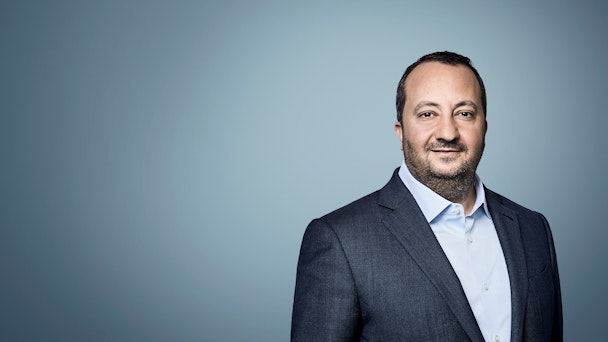‘The future is a mixed ecology’: CNN global president on why it paywalled UK livestream
CNN recently announced it will move its UK digital livestream to a paid-for model come June, like much of the news industry. Rani Raad, president of CNN worldwide commercial, reflects on the changing nature of 24-hour network news.

‘The future is a mixed ecology’: CNN Worldwide president on paywalling UK livestream
The global news provider is putting the livestream of CNN International, once readily available on its site, behind a subscription in the UK. CNN argues that the subscription income will help improve the product and make it more readily available to news lovers without them having to pay for TV packages like Sky, Virgin TV, BT and Freesat. The CNNI livestream will be accessible on mobile and desktop, and, at least at launch, Rani Raad says it will be ad-free – although that may change down the line.
There remain questions marks over the exact launch date (some point in June) and the price. For their fee, instead of blank ad break gaps viewers will be greeted with a new line of shows designed to fill the space. The product launches first in the UK, but could be expanded internationally.
While the live video component goes behind a paywall, Raad emphasises that CNN remains an accessible news source with free content on CNN.com and the app.
Raad says: “It increases the ways that people can experience CNN, generates new revenue opportunities for us beyond traditional distribution and advertising, and creates a different way for us to engage with and understand our audiences.”
The UK is CNN’s largest market behind the US and Canada in terms of digital audience, and it grew by 73% in 2020. So on top of the TV carriage deals, it was ‘experimenting’ with the CNN livestream. It’s seen enough demand on the product to warrant the monetization. “As consumer behavior changes and we see significant digital audience growth in the UK, we see an opportunity to increase our offering in the digital space.”
CNN’s data suggests that the current audience of the livestream have high incomes, are well educated, are most likely to be in a management or c-suite role and predominately are in the 25-54 age group. It’s a group with a high propensity to pay for the product.
Raad says: “There is a strong appreciation for CNN in the UK, with last year’s Ofcom news consumption study rating CNN among the UK’s top news sources.”
But to convince early subscribers of the value proposition, it will run with no ads. Raad says: “The ad-free proposition at the beginning means we can provide our subscribers something unique and offer them extra editorial content in the ad breaks that they wouldn’t be able to see elsewhere.” It may become an ad-funded service down the line, dependent on how many people buy into it, but Raad insists any ads must be “additive to the consumer experience”.
But with News UK turning its back on a TV launch and the coming GB News making all sorts of promises, we have to ask, what’s the purpose of a rolling news channel in 2021?
Raad says: “When there is a big event then people still turn on the TV to see it for themselves, follow all the developments and – most importantly in this age of disinformation – get their facts from a trusted and credible news source. The future is a mixed ecology of course, which is why CNN has invested significantly in our digital offering as well as in areas such as audio and newsletters.”
The latest quarterly ratings said CNN reached more than 350,000 25-54 year olds on US cable, of a combined 1.3 million. Cable’s still delivering. Globally, it estimates it is distributed to around 450 million households and hotel rooms. In digital, in February 2021, Comscore had it reaching 192 million unique multiplatform visitors. Newer mediums of audio downloads and newsletter subs grew by 75% and 90% respectively year-on-year. There’s more than TV on the agenda, but the news channel will remain an “important part of the mix for some time”.
As the wider news industry supposedly pivots to paid, Raad believes that user engagement levels should determine access. “There will inevitably be different levels that people access and engage with our content, which should be reflected in both the consumer proposition and payment relationship. In line with this rationale, we would charge heavy CNN users in the UK directly for their easy access, ad-free experience of CNN International on CNN.com while still ensuring that important journalism is available without charge [elsewhere].”
But it is wise of the business to continue diversifying its income after a cutting ad drought during the pandemic bled many newsrooms dry. But advertising isn’t off the agenda. Raad’s thinking of innovating the advertising product for an “audience-first approach that uses data and creativity to connect advertisers with their customer base in a premium CNN environment”. The belief is that accurate ads are valuable to both the client and audience. But the product will have to bridge the buying habits connected with a TV and digital ecosystem that a lot of players are working to modernize and unify. “It is still important for us to diversify our consumer offering and commercial revenue streams, which is why we are taking this paid-for step in the UK.”
And that largely has to be invested back into the product, because that will be what separates the winners from the losers. “The success of news providers, whether operating a traditional, D2C or hybrid model, will revolve around trusted, quality brands providing valuable content ... the market is going to get even tougher for any news provider producing content that consumers don’t see as truly valuable or distinctive.”
The Drum explored the Future of TV earlier this month. Don’t forget to sign up for our Future of Media briefing here.

